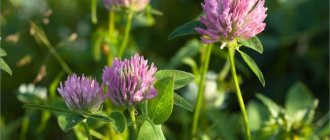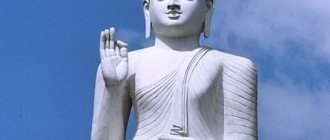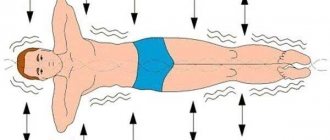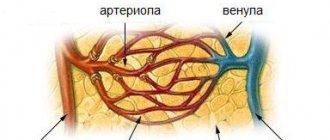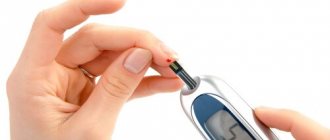The benefits of yoga for the heart and blood vessels:
- normalizes the condition of hypertension, gradually and safely lowering blood pressure;
- cleanses blood vessels from “bad” cholesterol;
- accelerates blood flow;
- stabilizes the functioning of the respiratory system, improves the supply of oxygen to the cells of internal organs and systems, and promotes weight loss.
It is believed that yoga classes are identical to classical physical activity that is used in official medicine.
For arrhythmia, the most effective exercise is in the “lotus” position, performed in the classical way. After a person stays in this position for 10 - 30 seconds, you need to take a deep breath and tilt your torso forward - the best option is to touch your forehead to the floor. Holding the air in your lungs, you need to lock in the pose for 5-6 seconds. If you are overweight, you can limit yourself to bending your body down while taking a deep breath.
The second exercise from the yoga course is lifting straight legs one at a time from a supine position. When lifting your right leg, take a deep breath, and when lifting your left leg, exhale. Having fixed for 3 - 10 seconds with one lower limb raised, it is lowered to the floor and exercises are carried out on the second.
Yoga rules:
- breathing should be calm, even and deep;
- It is better to perform classes in the morning, or 3 hours before a night’s rest;
- 3 hours must have passed since the last meal;
- the study room should be fresh; Perform the complex for arrhythmia only once a day.
Yoga is not a complete treatment for arrhythmia! Do not interrupt treatment prescribed by your doctor. Regular practice of the described exercises will make attacks of arrhythmia less intense and rare.
Exercise for pain:
- "Heart Breathing" It must be performed before each pose, but can also be used as an independent exercise: lie on your back, relax, even out your breathing; “pull yourself together”, stretching your arms along your body, connecting your legs, but do not strain your muscles; Taking a deep breath, raise your left hand up, place it behind your head and place it on the floor, palm up; simultaneously with raising the arm, the heel of the same leg should “move” forward; after 2-3 seconds of deep exhalation, the hand returns to its original position; The exercise is repeated for the other upper limb, then for both at once.
- Kumbhaka. Helps relieve stress and irritation and calm down. Can be performed in any comfortable position - lying, sitting, standing: close your eyes, relax; take a slow, deep breath and hold your breath for 30 seconds; immediately exhale - slowly and through the nose.
Important: you need to start with a short breath hold, literally for 5 - 8 seconds, but this indicator needs to be improved every day.
- Ujan. Used for pain due to arrhythmia. You need to sit or lie down comfortably, you can stand. A deep breath is taken through the nose, while mentally counting to 8, then the breath is held for 3 - 5 seconds. The exhalation is done through the mouth, the teeth are clenched and a drawn-out sound “s-s-s” is made - in the mind the count is kept to 16. The cycle is repeated 5 times. Do not perform if you have heart disease associated with high blood pressure!
Asanas to strengthen the heart and blood vessels:
- Tadasana. Stand straight on the mat with your feet almost together. With your feet, try to stretch the mat to the sides, at the same time pulling your tailbone as far forward as possible and straightening your shoulders, your knees should “look” forward, your gaze straight ahead.
- Reverse deflection. From a standing position, raise your arms straight up, bend your knee joints slightly. Bend back while pushing your pelvis forward.
- Ushtrasana . Kneel down with emphasis on your toes, arch your back, grab your feet with your hands - your torso should be perpendicular to the floor. Take a deep breath - the stomach protrudes forward as much as possible, exhale - assume a sitting position on the floor.
Read more in our article about yoga for the heart and blood vessels.
Why does my heart hurt?
Without exercise, the heart becomes weaker. The heart muscle weakens from illness and a sedentary lifestyle. When the heart weakens, various pathologies can develop, since poor blood supply prevents sufficient nutrition and oxygen from reaching the organs. The condition of the blood vessels is also very important.
A person with a weak heart has the following symptoms:
- Little physical activity causes fatigue and palpitations.
- When climbing stairs or walking quickly, you feel a lack of oxygen.
- Excess weight appears, blood pressure rises, and other organs suffer.
The benefits of yoga for the heart and blood vessels
How yoga classes have a beneficial effect on the condition of the heart and blood vessels has not yet been precisely clarified. But the fact that this really happens has been proven at the level of official medicine. Doctors say that yoga:
- normalizes the condition of hypertension, gradually and safely lowering blood pressure;
- cleanses blood vessels from “bad” cholesterol;
- accelerates blood flow.
Additionally, exercises stabilize the functioning of the respiratory system, improve the flow of oxygen to the cells of internal organs and systems, and promote weight loss. It is believed that yoga classes are identical to classical physical activity that is used in official medicine - jogging or interval training on a treadmill, cycling, active walking.
We recommend reading the article about breathing exercises for the heart. From it you will learn about the benefits of exercises to strengthen the myocardium, general recommendations for implementation.
And here is more information about exercises for the heart.
How does yoga help with heart problems?
Is it possible to help yourself if your heart is bothering you? Yes, this is possible thanks to special yogic asanas.
But you should start exercising only after consulting a doctor, who will indicate the reason for the weakening of the heart muscle. It is important that there are no severe pathologies.
Yoga exercises can strengthen both the heart and the muscles of the body. Special asanas gently and delicately strengthen the heart muscle and blood vessels than traditional sports.
If a person wants to improve his health, yoga exercises should become systematic. It does not take much effort and time, but the result will be positive.
Kumbhaka
This yoga movement for heart pain allows you to control your pulse and calm down during stress. The complex reduces the heart rate, so it can be used even for tachycardia.
To perform the exercise, you must take a standing, sitting or lying position. You must concentrate on the work of the heart muscle. Take a deep and long breath through your nose, then hold your breath for 10-30 seconds and slowly exhale (also through your nose). The Kumbhaka breath-holding technique is useful for a sick heart, but you need to start with 8-10 seconds, gradually extending the hold time by several seconds every day.
Scientific evidence for the productivity of yoga
The California Scientific Institute conducted special studies that proved that systematic yoga will help eliminate the development of diseases of the cardiovascular system. By choosing special exercises, you can lower blood pressure, normalize your pulse, and strengthen your heart muscle without resorting to pills. Asanas will also come to the rescue after cardiac surgery; they will reduce stress and anxiety. The yoga instructor and author of some yogic projects notes that complex exercises have a great effect on all human organs. But to strengthen the cardiovascular system, it is important to use asanas that open the chest. These are the exercises presented in the complex proposed below.
Notes
When you gain a little experience, you can add Paschimottanasana after Utkatasana to compensate for the backbends. Be sure to do child's pose after cobra pose (again, to compensate for the backbend), and also lie on your back, similar to Savasana (corpse pose).
These are the relatively simple exercises for the heart and blood vessels that yoga offers. Of course, everything is not limited to them - there are many more yoga poses to improve the health of the entire cardiovascular system and more. But these asanas can be a good basis for regular practice.
Important: These yoga exercises are marketed as heart-strengthening; If you have any pre-existing heart conditions, be sure to consult your doctor before attempting these yoga poses.
Features when selecting asanas
There are many asanas that strengthen the heart muscle, but they must be selected taking into account the state of health and how the muscles are developed.
At the initial stage, it is recommended to train under the supervision of an instructor.
When selecting exercises, you need to be aware of priorities and limitations. So, in order to lower blood pressure, it is necessary to perform special breathing asanas and meditations to relieve internal anxiety. If you are overweight, yogic complexes that work special muscle groups help. When a person is sick, asanas are selected that affect the problem and have a beneficial effect on the entire body.
Cardiac vasospasm (narrowing of blood vessels)
In everyday clinical practice, it is sometimes very difficult to distinguish between an attack of angina and myocardial infarction, based on the characteristics of cardiac pain. Nevertheless, it was accepted that the cause of both attacks should be sought in arteriosclerosis and thrombophlebitis.
To date, research at the University of Pisa (Italy) has led scientists to the conclusion that mini and maxi attacks are formed by the same mechanism, which is called coronary vasospasm. It was found that coronary blood vessels are blocked by partial or complete spasm precisely at the moment of emotional and mental stress.
The signal from the lymphatic (emotional) centers of the brain is rapidly sent by the hypothalamus to the walls of the coronary vessels and the reaction of the sympathetic nervous system immediately occurs - special nerve fibers narrow the vessels leading to the heart. It was a revolutionary discovery! And scientists made a reasonable conclusion that blood clots and arteriosclerotic hardenings in the heart could have formed after autopsy of the body... Thus, it was established that the main cause of heart attacks and angina pectoris should be sought in emotional and mental stress.
Unfortunately, in medical circles there has not yet matured an understanding of the importance of introducing Yoga Nidra into the widespread practice of preventing and treating heart diseases. It is quite obvious to us that Yoga Nidra is capable of changing the mental-emotional climate of a cardiac patient through a complex of relaxation and distraction and averting incipient angina or heart attack.
As early as 1948, American cardiologist Aaron Friedel described how concentrated nostril breathing (known among yogis as anuloma viloma, or psychic breathing) was the most effective, fast-acting, drug-free remedy that radically controlled and relieved chest pain in cardiac patients.
It is only now that many authorities are beginning to recognize that Yoga Nidra is perhaps the best therapy for the treatment of coronary heart disease. A patient practicing Yoga Nidra is immersed in a state of deep mental peace and emotional relaxation, which in turn frees the patient from the trap of coronary vasospasm and deflects the guillotine of a heart attack.
The future role of Yoga Nidra in coronary care and treatment management will be certain. By now, the importance of Yoga Nidra in the science of preventing cardiovascular diseases is widely known. However, the potential of this ancient science is far from exhausted.
Asanas for the prevention of cardiovascular diseases
The complex is designed to strengthen the cardiovascular system. For those with heart problems, it is important to consult a doctor before performing exercises.
All you need for practice is a mat. Repeat each asana 3-5 times.
Mountain Pose (Tadasana)
Performance:
- Stand on the edge of the mat, legs apart, feet parallel to each other.
- Slightly spreading the mat with your soles, point your knees forward.
- Pull your pelvis in.
- Open your chest, moving your shoulders back and down.
- Pull the crown up.
Garland Pose (Malasana)
Execution sequence:
- Place your feet wider and point your toes slightly apart.
- Place your palms in front of you.
- Exhaling, do a full squat, do not move your heels.
- Spread your hips to the sides, helping with your hands. Lower your pelvis low, pull your tailbone in.
- The crown extends upward, stretching the vertebral axis.
- Inhale and stand up.
Extended side angle (Utthita parsvakonasana)
Execution order:
- While in Malasana pose, place both hands on the surface.
- Take your left leg back and straighten it, and turn your foot outward by 45 degrees. The right one is to bend the knee so that a right angle is formed.
- Place your right hand in front of your right foot.
- The shoulder should be in an exact projection above the hand. The right arm and shin are parallel to the surface.
- Inhaling, raise your left arm upward, turning your torso. The upper limbs form an even vertical, look up.
- With subsequent exhalations, try to lower your pelvis lower, and move your left hand back further.
- The back muscles are relaxed, open the chest to the maximum.
- Exhaling, the left hand lowers to the surface. Take a step back with your right foot, and pull your left foot towards your left hand.
- Do similar actions in the opposite direction.
- After this, pull your right leg towards your right hand and sit on the mat, legs bent (feet on the surface).
Table Pose (Goasana)
In a sitting position, take the upper limbs back and lower them to the surface, phalanges forward. Inhaling, push off the surface with your feet and palms. Raise the pelvis, stomach and chest up to the maximum so that the body is parallel to the surface. Look up, tense your buttocks, point your navel inside the body. After staying in the pose for 10–15 seconds, lower your buttocks to the surface and lie on your back. Align the lower limbs, place the upper limbs along the body.
Bow Pose (Dhanurasana)
From the previous position, roll over onto your stomach, legs apart, arms along the body. Bend your lower limbs at the knees and grab the outer part of your ankles with your hands, bringing your feet together. Tighten your buttocks and, while inhaling, lift your lower limbs and chest off the surface. Don't throw your head back, look forward. As you exhale, releasing your hands, smoothly lie down on the surface.
Camel Pose (Ushtrasana)
Execution sequence:
- Sit on your heels, straighten your back and kneel slightly apart.
- The fingers of the lower extremities rest against the surface.
- With tension in the gluteal muscles, exhaling, begin to smoothly bend back.
- Place your hands on your heels one by one. Keep your thighs and upper limbs perpendicular to the surface.
- While inhaling, pull your stomach forward, turning your chest and trying to direct it upward.
- Look up, stretching your neck muscles.
- Exhaling, release your hands, straighten up and sit on your heels.
Beneficial Yoga Exercises for Heart Health
Tadasana (mountain pose, variant)
Stand straight with your feet and heels together, arms down, palms resting on the outer thighs.
Stand calmly, steadily, breathe normally. As you inhale, raise your arms in front of your chest, placing your palms together in the Indian greeting "Namaste" (this hand position is called Anjali Mudra).
As you exhale, rise onto your toes and stay in this position, trying to maintain balance.
As you exhale, lower your heels to the floor.
Now, in this pose there are additional development options : 1) rising on your toes, try to close your eyes, while focusing on maintaining a stable position; 2) rising on your toes, while inhaling, stretch your arms above your head - maintain this position for as long as you can without undue tension, then lower yourself onto your heels, lowering your arms into Anjali Mudra, then along your body. In this version, you don’t have to close your eyes, but direct your gaze either forward or at your palms raised up.
One more thing : perform this pose for 5-15 minutes every day: you can first do several approaches, then try to stay in the final position for as long as possible.
Vrikshasana (tree pose)
We stand in the same position as at the beginning of Tadasana. We fold our hands into Anjali Mudra.
Bend your left leg and place your foot on the inner surface of your right thigh. Try to move the knee of your bent leg as far back as possible; keep your back straight.
Now, while inhaling, raise your arms above your head, stretching them upward; the gaze is directed forward.
In the final position, stay for a while, breathing freely and focusing on maintaining balance. Try to relax.
As you exhale, lower your hands into Anjali Mudra, then your left leg. Repeat with your right leg.
Virabhadrasana (warrior pose)
Stand up straight with your gaze directed forward. As you inhale, raise your arms above your head to your sides, bringing your palms together at the end.
As you exhale, jump with your legs about 90-100 cm apart.
Rotate your right foot 90 degrees to the right, and slightly to the right your left foot, while simultaneously rotating your entire body to the right.
Inhale, and as you exhale, squat down on your right leg, bending it at the knee until your right thigh is parallel to the floor and your shin is perpendicular.
Keep your chest open, your arms above your head, your gaze directed forward, and breathe normally.
As you exhale, return to the starting position and repeat on the other side.
Option: You can place your hands in Anjali Mudra if you find it difficult to stretch them upward.
Utkatasana
Stand straight with your feet slightly apart. Place your hands in front of your chest in Anjali Mudra.
Inhale and exhale, and as you inhale, extend your arms up above your head, while bending your knees so that your hips drop - almost until they are parallel to the floor.
The back arches slightly, the shoulders are straightened, the gaze is directed forward.
Close your eyes, breathe naturally, and focus on maintaining balance.
After some time, return to the starting position. Perform 2-3 approaches per practice.
Important: Avoid overexertion, especially in the lower back area, and if you have not previously exercised on a regular basis.
Bhujangasana (cobra pose)
Lie on your stomach, place your hands in front of you, chin on the floor.
Place your forehead on the floor, place your palms on each shoulder, and close your eyes.
Exhale, and as you inhale, slowly, without using your hands, lift your head, then your shoulders, then, using your hands, lift your body.
In the final position, look in front of you, breathe normally.
As you exhale, lower yourself to the floor and relax. You can perform 2-3 approaches per practice.
Important: When you first start practicing snake pose, do not throw your head back. Also remember that when lifting your torso above the floor, your back muscles always work; do not allow “breaking” in the lumbar region when you bend back.
After Bhujangasana, perform Balasana (child's pose), which is described in the article “6 Yoga Poses to Relax the Muscles of the Back and Neck,” just do it without a blanket or pillow, but simply by placing your head (forehead) on the floor.
Then, at the end of the practice, simply lie on your back for a few minutes to relax.


